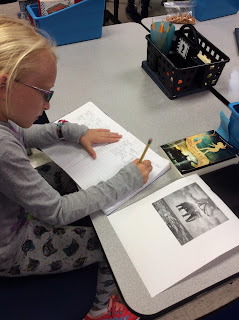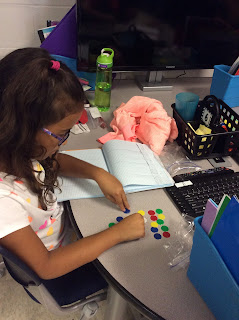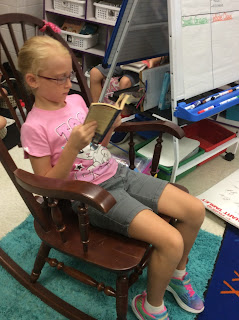Monday, November 28, 2016
Monday, November 21, 2016
Weekly Newsletter: Week of November 21
Please click HERE to see this week's third grade newsletter.
Hope you and your family have a happy and safe Thanksgiving break! :)
Hope you and your family have a happy and safe Thanksgiving break! :)
Wednesday, November 16, 2016
Problem Solving
Over the past few weeks, you might have heard the words "short answer question" at home. This is because we have been working heavily on solving real world situations in math workshop. Students were introduced to the short answer rubric and throughout last week, practiced each category independently. To culminate this study, students used one math workshop to complete an entire short answer question on their own, from beginning to end. The next day, peers were asked to analyze and evaluate each other's work then participate in a discussion about strengths and areas of improvement.
Here is an example of a proficient short answer question.
Below are some pictures from the collaboration that took place during this activity!
Here is an example of a proficient short answer question.
Below are some pictures from the collaboration that took place during this activity!
Tuesday, November 8, 2016
Monday, November 7, 2016
What is magnetism?
As we end our science unit on force, students are exploring the invisible force of magnetism. Throughout these few days, students rotated to different stations that ranged from exploring different types of magnets to discovering what is magnetic. To continue this conversation at home, try to see what household items are magnetic. Have your student first predict, then test.
Below are a few pictures from these stations.
Below are a few pictures from these stations.
Tuesday, November 1, 2016
Tuesday, October 18, 2016
Monday, October 17, 2016
Weekly Newsletter: Week of October 17th
Click HERE to access this week's third grade newsletter. As always, let me know if you have any questions, comments, or concerns. Have a great week!
Main Idea
Last week, we started discussing the difference between fiction and nonfiction texts. Readers determined that in a fiction text, the author is usually trying to teach you a lesson. In nonfiction, however, the author is trying to teach you about a certain topic. We concluded that this is called the main idea! To begin our work on finding the main idea, students looked at pictures around the room and tried to determine the topic and main idea of the pictures; essentially, how the pictures go together. This week, we will be using the following chart to find the main idea in some high interest nonfiction articles!
At home, encourage your student to expand their reading diet to include nonfiction texts. While reading, go through this list of steps to finding the main idea and practice it together!
At home, encourage your student to expand their reading diet to include nonfiction texts. While reading, go through this list of steps to finding the main idea and practice it together!
Thursday, October 13, 2016
What does independent reading look like?
As an educator teaching in the world of technology, I have had to rethink the way independent reading looks like in the classroom. With the abundance of reading apps and websites and the change in ways our students think and learn, independent reading is different than each student with a chapter book in their hands, flipping the pages as they go. In the classroom and at home, students may read a book online, swiping with their finger to flip the page. You might see them listening to a story being read aloud and reading the words with the reader. A student might also listen to an audio book, forcing them to infer and visualize what the characters are doing based on what they hear.
When reading at home with your student, I challenge you to open your mind to what independent reading can look like.
When reading at home with your student, I challenge you to open your mind to what independent reading can look like.
Michael is using the Epic App to listen to a story being read. He does not have the text in front of him, so he is forced to infer and visualize the story.
Ethan listens to a reader while tracking the words across the page. The Capstone website lights up each word as it is being read, increasing the rate a student may read independently.
Lexi enjoys a good old-fashioned book from the classroom library!
Avery is using Big Universe to read a non-fiction book on tsunamis. This website does not read to the students but gives them high interest books that reinforce independent reading skills.
Tuesday, October 11, 2016
How do writers transform real life moments into a story?
As we begin our next writing piece, writers are first asked to develop story ideas. One way that writers get ideas for fiction is by paying attention to the moments and issues in our own lives. Students learned and discovered that E.B. White got the idea for Charlotte's Web by lying on a bale of hay in his barn, watching a spider in her web. The barn animals, the pigs, and the geese were all around, and he wrote about that moment in his writing notebook.
Writers were asked to look at different pictures around the room and transform those moments into story ideas. After drafting many ideas, they will be asked to choose one that fits the qualities of a proficient narrative to take through to publishing. This is an exciting process and so fun to watch!
Writers were asked to look at different pictures around the room and transform those moments into story ideas. After drafting many ideas, they will be asked to choose one that fits the qualities of a proficient narrative to take through to publishing. This is an exciting process and so fun to watch!
What are text features?
This week, readers dived into non-fiction texts and specifically focused on how the text features help them as a reader. At the end of the week, each student was assigned a text feature and created a Pic Collage poster to share what they know about that text features and it's purpose. All posters were then combined to a Padlet, shown below.
Tuesday, October 4, 2016
Monday, October 3, 2016
Raging Rectangles
Looking for a fun and quick math game to play at home with your student??? Click HERE to download and print off a copy of Raging Rectangles.
What does it mean to multiply?
As we begin to understand what it means to multiply, students are exploring multiplication using different math manipulatives. Third grade standards require students to interpret 5 X 7 as the total number of objects in 5 groups of 7 objects each. For example, you could say "There are 5 students and each student has 7 pencils. How many pencils are there?" When using manipulatives, mathematicians in third grade would create 5 groups of 7 OR an array of 5 rows and 7 columns, then count to find 35.
I know this is very different from the way you and I learned how to multiply, but please praise your student on learning what this operation means, rather than just learning the facts. Their deep understanding of what it truly means to multiply will be amazing and I can't wait to see what real world problems they can solve using this understanding!
At this point, please continue to work on and practice addition and subtraction skills at home while we continue to develop an understanding of this new operation in class.
Below are some pictures from one of our first days working with equal groups and arrays!
I know this is very different from the way you and I learned how to multiply, but please praise your student on learning what this operation means, rather than just learning the facts. Their deep understanding of what it truly means to multiply will be amazing and I can't wait to see what real world problems they can solve using this understanding!
At this point, please continue to work on and practice addition and subtraction skills at home while we continue to develop an understanding of this new operation in class.
Below are some pictures from one of our first days working with equal groups and arrays!
Monday, September 26, 2016
Weekly Newsletter: Week of September 26
Please click HERE to see this week's third grade newsletter. Let me know if you have any questions, comments, or concerns! :)
Subtraction Strategies
Below is a copy of our anchor chart of subtraction strategies. Throughout the year, please make sure your student is always showing their work using one of these strategies. The traditional method of borrowing and carrying is not developmental for third graders to learn and will not be taught until fourth grade. Please let me know if you have any questions.
100/1,000 or Bust
This past week, mathematicians practiced their knowledge of subtraction skills while playing 100 or Bust OR 1,000 or Bust. The object of the game was to get as close to 0 without going under. Students either started with 100 or 1,000, depending on their game board. They needed to stay very organized with their work in order to see what their difference was, and the student who got closest to zero won! This was such a fun game and can easily be played at home. Let me know if you'd like a copy of the game board. :)
Monday, September 19, 2016
Addition Strategies
Below are the addition strategies that have been taught and practiced so far this year. Throughout the year, your student will be asked many times to show their thinking when solving an addition problem. These strategies show their understanding of place value and the operation. Please DO NOT teach the traditional method of addition (crossing out and putting the new number above) that we you and I were taught in school. Although this method is more efficient, it does not show understanding of the operation, only the memorization of a process. After students have mastered the strategies below, the traditional method will be taught in fourth grade. Let me know if you have any questions about this! Thanks!!
Sunday, September 18, 2016
Third grade engineers
As you know from a previous post, engineers in third grade have been working to solve a problem involving our water bottles. Students were asked to use certain materials to create a water bottle that would keep ice cold throughout the day. Over the course of the week, they worked in groups to design and create their cup. On Friday, students were able to make final changes and test their cup. See below for pictures from Friday!
Thursday, September 15, 2016
Updated Wish List
Click HERE to see an updated 2016-2017 class wish list. Thank you in advance for anything you donate to the classroom!!
Monday, September 12, 2016
Weekly Newsletter: Week of September 12
Click HERE to see this week's third grade newsletter. Be sure to look below to see what's been happening in the classroom! :)
Sunday, September 11, 2016
Third Grade Selfies
To practice finding character traits and using evidence to explain their thinking, students were asked to think about traits that describe themselves. Below are a few examples!
What is an engineer?
We are so excited to begin our first science unit! For our first week, students explored what it means to be an engineer. See our thinking on the chart below and keep checking back for updates on our first engineering activity!!
What are character traits?
This past week, readers began thinking about how to describe the character in their story using a character trait. A character trait is an adjective that is used to describe someone's personality. We discussed the difference between a feeling and a trait. Feelings can change based on the situation but a character trait is something that describes who you are as a person. In the pictures below, students are determining a positive trait vs. a negative trait.
While your student is reading this week, ask them questions like:
-What is your character doing? Saying? Acting like?
-How can you describe the main character using a character trait?
-What evidence do you have to support your thinking?
While your student is reading this week, ask them questions like:
-What is your character doing? Saying? Acting like?
-How can you describe the main character using a character trait?
-What evidence do you have to support your thinking?
Tuesday, September 6, 2016
Weekly Newsletter: Week of September 6
Please click HERE to see this week's 3rd grade newsletter. Be sure to read the previous posts below to see what's been happening in the classroom! :)
Monday, September 5, 2016
READING STAMINA GOAL REACHED!!!
Please help us in celebrating one goal already reached this year!! We have reached 30 minutes of reading stamina! :)
Technology Promise
Parents and families,
As you may have already heard, we began using our iPads this week! Before getting them out, though, we decided on a few guidelines that we will try to live by this year, as seen below on our Technology iPromise chart. These guidelines were decided by the students and as each student signed their name, they agreed to follow these. So far, we have explored a few reading and math apps and we are excited to continue to using them this year! If you have a tablet device at home, please consider using these guidelines as well. Having the same expectations at school and home will help prevent damages.
As you may have already heard, we began using our iPads this week! Before getting them out, though, we decided on a few guidelines that we will try to live by this year, as seen below on our Technology iPromise chart. These guidelines were decided by the students and as each student signed their name, they agreed to follow these. So far, we have explored a few reading and math apps and we are excited to continue to using them this year! If you have a tablet device at home, please consider using these guidelines as well. Having the same expectations at school and home will help prevent damages.
Flexible Seating
Throughout the week, students have experimented with flexible seating in the classroom. There are many different work places around the room that students are able to sit, if the activity permits sitting around the room. Students were asked to reflect on their learning styles and what helps them learn best. If sitting at a table is best for that student, they will choose those places. However, I do not expect them to sit in a chair at a table all day if that is not helping them learn. Everything we do has a purpose, including choosing to lay on a carpet during work time! I have been very impressed with each student's choice as they experiment with the different work places around the room and begin to understand themselves as a learner! Let me know if you have any questions about this!
Monday, August 29, 2016
Weekly Newsletter: Week of August 29
Click HERE to see this week's third grade newsletter. Please be sure to pay close attention to the description of math WIN (What I Need) time on the second page. As always, let me know if you have any questions or comments!
Have a great week!
Have a great week!
Sunday, August 28, 2016
What a great week!
This week, readers, writers, and mathematicians worked on their stamina during work time. As a class, we are trying to reach 30 minutes of uninterrupted work time. Increasing our stamina will allow us to spend more time working on learning activities later in the year!
Reading workshop--Students worked on finding just right books. These are books that a student is interested in and can read and understand most of the story. After choosing just right books, students practiced their reading stamina. We are currently up to 16 minutes of reading stamina! More than halfway to our goal!!
Writing workshop--Students are gathering an "Idea Bank" in their notebook of ideas to write about. Authors use many different ways to gather ideas. Below, you can see students completing a Heart Map of things that matter to them. These things can then later be turned into a story idea!
Building our classroom community--Students were asked the question "What would make this year the best year yet?" After writing down their ideas on sticky notes, they were given time to share with a group and find similarities in their thinking. Stay tuned for the completed project!
Subscribe to:
Comments (Atom)





















































